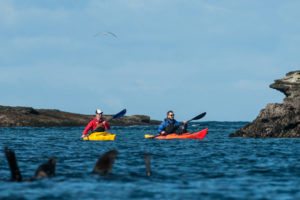Good information from Canoe and Kayak Magazine and the United States Coast Guard. Original post here. -KH
Nothing is as peaceful as a beautiful day on the water paddling your canoe or kayak. Paying attention to the risks associated with recreational boating is important for a safe and enjoyable adventure. The information are provided to raise awareness, and if followed, will help protect you and your loved ones.
- The following safety gear should be worn while in your canoe or kayak:
- A personal flotation device (PFD), or a life jacket, is essential. On the off chance you end up in the water, a PFD may save your life. Make sure your PFD fits comfortably; Type III is generally recommended for paddle sports.
- Keep a whistle attached to your life jacket for communication with other paddlers on the water.
- Wear bright and noticeable clothing to be visible to other boaters.

- Another key factor to avoiding hazards is understanding the water and weather conditions:
- The tides and currents change throughout the day and depending on the weather may be stronger at certain times. Even if you are familiar with a particular waterway, it is still important to make sure tides, currents, and weather are checked shortly before departing on a trip.
- Be aware of the air and water temperature, if either is less than 60 degrees Fahrenheit, wearing fleece layers or possibly a drysuit is recommended. Being immersed in water as warm as 50-60 degrees Fahrenheit can initiate Cold Water Shock.
- If there is low visibility due to fog or darkness, it is best to stay off the water. This is especially critical for smaller non-self propelled craft.
- If you capsize in cold water it is best to huddle instead of swim to shore unless the depth is shallow enough to walk ashore. The body’s first reflex is to gasp for air, increase heart rate and blood pressure, all of which may lead to cardiac arrest. Chances are the water will not be calm and the exhaustion of swimming will increase your heat loss more swiftly.
- In some waterways larger vessels may be a concern:
- Understanding the Rules of the Road on the water is as important as knowing traffic rules before driving a car. Having basic knowledge of vessel navigation lights and sounds as well as understanding what common navigational aids mean will help prevent accidents. Although many smaller inland waterways generally do not have high levels of vessel traffic, some smaller rivers are often transited by commercial deep draft traffic.
As an extra precaution to help the Coast Guard or other responders in case of an emergency, keep contact information on your equipment and let your family or friends know the location where you will be operating.
Lastly, it is highly recommended that recreational boaters take some boating safety lessons from their local Coast Guard Auxiliary or American Canoe Association.
See you on the water!